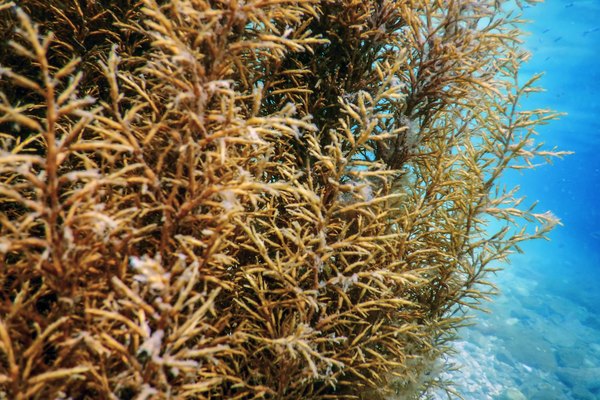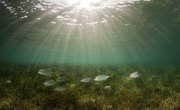
Earth is called the blue planet because of the vast oceans covering a majority of its surface. The oceans are home to many marine plants and animals, ranging from microscopic unicellular organisms to gigantic seaweeds.
Marine plants play an important role in marine ecosystems as energy and nutrient producers.
What Is the Pelagic Zone of the Ocean?
Open oceans span several kilometers from coast to coast and run hundreds of kilometers deep. To study oceans and its organisms that live there, the open ocean is divided into different layers or zone.
The definition of the pelagic zone is that area of the ocean excluding its coastal waters and ocean floor. The pelagic zone is further divided into epipelagic, mesopelagic, bathyal, abyssal and hadal zones according to their depth from surface of the ocean.
Pelagic Zone Plants
Many diverse organisms live in the pelagic zone from the Arctic waters to the tropical seas. As you move deeper into the pelagic zone, the type of plants found in the zone vary greatly. The upper zones of the pelagic zone receive ample sunlight, and photosynthetic plants typically are found here.
Photosynthetic plants are the producers of marine ecosystem. They trap and convert solar energy into nutrients and oxygen, which are essential for marine organisms to survive. Photosynthetic plants such as phytoplanktons, dinoflagellates and algae live in the pelagic zone. They exist in unicellular, multicellular or colonial forms.
Phytoplanktons
Phytoplanktons are microscopic, unicellular, pelagic zone plants. (Note: some phytoplankton are actuall bacteria or protists although many are single-celled plants).
They are autotrophic and contain chlorophyll, a pigment essential for photosynthesis. Phytoplanktons live on the surface of oceans and are the main source of food for fish and other marine animals.
Dinoflagellates
Dinoflagellates are unicellular microscopic organisms characterized by the presence of flagella, a pair of whiplike filaments used to move from one place to another. These small organisms are not actually plants; they're plant-like protists.
Dinoflagellates are an indicator of the health of a particular water body as their population is extremely sensitive to changes in water composition.
Overpopulation of dinoflagellates because of changes in the nutrient content of water leads to a phenomenon called red tide, where the water turns reddish brown. This happens because some dinoflagellates have red or brown pigments, making the water look red.
Diatoms
Like dinoflagellates, diatoms are not plants. They're actually plant-like protists.
Diatoms are radial or feather-shaped unicellular algae with a unique external skeleton called a frustule, which is made of transparent silica cell walls. Diatoms produce almost 25 percent of atmospheric oxygen. Like dinoflagellates, diatoms too are an indicator of the health of a body of water.
Seaweeds
While seaweed does look like a plant, seaweed is not a plant. It's also a type of protist.
Seaweeds are large floating algae that grow in water closer to coastal waters. The long, ribbonlike leaves of seaweeds provide shelter to breeding fish and aquatic animals such as amphibians, sea horses and sea otters. Seaweeds may be red, brown or green, depending on the pigments they contain and the amount of chlorophyll they have.
Seaweeds such as kelp can grow many meters in length across vast areas of the ocean floor and form kelp beds. Kelp beds where kelp leaves form a canopy, like trees in forests, are called kelp forests.
Seagrass

Seagrass is not actual aquatic grass but a photosynthetic pelagic zone plant with well-defined roots, leaves and flowers. It usually grows in shallow water near coastal areas. Seagrass has thick roots that anchor it to the ocean bed and prevent it from being uprooted by extremely strong water currents.
Seagrass grows in large areas, forming seagrass beds that act as breeding grounds and nurseries for marine organisms and food for aquatic animals, such as dugongs and manatees.
What Plants Live in the Bathyal and Abyssal Zones?
As you go deeper into the ocean, the light becomes dimmer and dimmer until the bottom is pitch dark. This region is divided into bathyal and abyssal zones. The abyssal zone is the zone near the ocean bed, and the zone above it is called the bathyal zone.
Sunlight does not penetrate these two different zones of the ocean, and plant life does not exist here. This is why bottom feeders live on debris and plant matter that sinks to the ocean floor from the upper zones.
References
About the Author
Kavita Naik is a freelance writer and instructional designer. She holds Bachelor of Science in Zoology. She has edited life science research papers for several major scientific journals. She has years of experience in designing and developing learning solutions for educational as well as professional purposes. She has also created Common Core-compliant curriculum.
